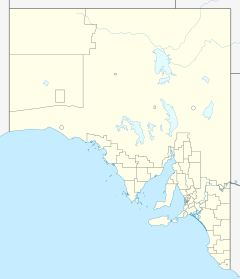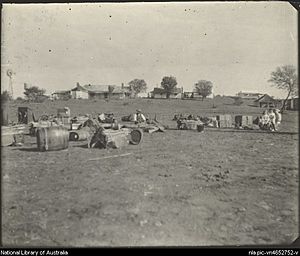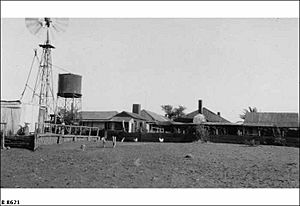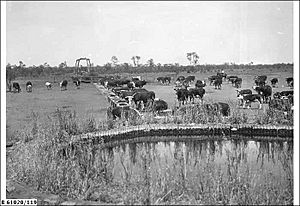Todmorden Station (pastoral lease) facts for kids
Todmorden Station, often just called Todmorden, is a very large cattle farm in South Australia. It is known as a pastoral lease, which means it's land rented from the government for raising animals.
Contents
Where is Todmorden Station?
Todmorden Station is located in a dry part of South Australia. It is about 82 kilometers (51 miles) northwest of Oodnadatta. It is also about 114 kilometers (71 miles) east of Marla.
Natural Features of the Area
The land here is very dry, or arid. Several creeks flow through the property, but only after it rains. These are called ephemeral creeks. Some of these creeks include the Alberga, Olarinna, and Coongra Creeks. They often have waterholes that stay wet for a while. These waterholes are important for watering the cattle.
The famous Oodnadatta Track also crosses through Todmorden Station. This track is a long, unsealed road. It connects Oodnadatta and Marla. Todmorden Station shares its borders with several other large farms. These include Lambina and Hamilton Stations to the north. Macumba is to the east. Wellbourn Hill is to the west. And Arckaringa and Wintinna Stations are to the south.
What is Todmorden Station Like?
Todmorden Station is huge! It covers an area of 7,169 square kilometers (2,768 square miles). This is divided into 32 large areas called paddocks. The station can support between 5,000 and 7,000 cattle.
Climate and Water Supply
The area gets about 175 millimeters (7 inches) of rain each year. However, the amount of rain can change a lot from year to year. Because of this, the cattle mostly drink from 32 bores. Bores are deep wells that bring water up from underground.
Land and Plants
The land is mostly rangeland, which is open country for grazing. In the north, you can find sand dunes and areas with mulga trees. The central part has flat, stony plains called gibber plains. Along the creek beds, there are sandy areas with coolibah trees. These trees grow near the creeks that flow into large dry lake beds, known as clay pans.
The station also has big areas of Mitchell grass and saltbush. These plants are very good food for the cattle.
Who Owns Todmorden Station Today?
Todmorden Station is currently owned by the Todmorden Cattle Company. This company is a family business. It is run by the Lillecrapp family, including Gordon, Mary, Douglas Lillecrapp, and Mary-Ann McMichael. They mostly raise a type of cattle called Poll Hereford. The family also owns three other farms further south in the Mid North region of South Australia.
The History of Todmorden Station
The land where Todmorden Station is located has a long history. It is the traditional home of the Yankunytjatjara and Antikirinya peoples. They have lived on this land for thousands of years. The Arrernte peoples to the north also have connections to this area.
Early European Exploration and Settlement
The first European explorer to travel through this area was John McDouall Stuart. He passed through in 1860. He went north past where Oodnadatta is today. He also explored the waterholes along the Neales River.
In 1872, the Overland Telegraph was built. This important line for communication went right through what is now Todmorden. This led to the first land leases being given out. Many of these leases were held by people who bought land hoping its value would increase.
By 1885, a Mr. Wooldridge held most of the leases in the area. The Great Northern Railway reached Oodnadatta in 1891. This made it much easier to move cattle to markets in Adelaide. This made raising cattle in the area much more appealing.
Naming the Station
Two brothers, Edmund and Walter Parke, came from a town called Todmorden in England. They partnered with Charles Walker. They took over many leases within the current station boundaries. They named their new farm "Mount Todmorden Station" after their hometown. The main house, or homestead, was built along the Alberga Creek in the 1890s. Edmund Parke died in 1901. At that time, the partnership owned both Todmorden and Henbury Station.
Changes in Ownership
Joseph Albert Breaden bought Todmorden in 1902 from the Parke and Walker partnership. At this time, the property was about 7,000 square miles (18,130 square kilometers) in size. It was sold with all the cattle. In 1906, Breaden had to sell his cattle because of a severe drought.
In 1907, explorer Frank Hann passed through Todmorden. He reported that the Alberga Creek was completely dry. All the small water sources, called soaks, had also dried up. However, in 1908, the area was flooded. About 6.5 inches (165 millimeters) of rain fell in just a couple of days. This caused Todmorden and many nearby stations to go underwater.
Breaden sold the station in 1923 to retire. The property was in good condition. It was bought by the Young brothers. They also acquired 3,000 cattle and 1,500 horses. In 1927, another drought hit the area.
Molly Breaden, Joseph Breaden's daughter, took over the property in 1945. She ran it with her nephew, David Gardiner, until 1962. After several years of drought, the Lillecrapp family bought the station.
Modern Developments
In 2004, an Indigenous land use agreement was made. This agreement was with the Yankunytjatjara and Antakirinja people. It allowed them to access their traditional lands. At the same time, it respected the rights of the station's owners.
In 2011, heavy rains caused major flooding at the station. Five people, including the manager Douglas Lillecrapp, were stuck there. The station received its average yearly rainfall in just 30 hours. Most of the property was underwater, and water flowed through the sheds. Later that year, large bushfires swept through the area. About 70,000 hectares (173,000 acres) of grazing land were lost. Lightning strikes started the fire. It burned for almost two weeks. A controlled burn, about 40 kilometers (25 miles) long, helped to stop it.
In April 2013, the land of Todmorden Station was officially named a "locality." This means it became a recognized place on maps.





